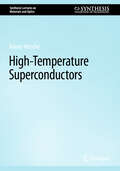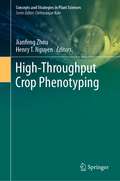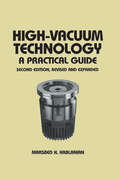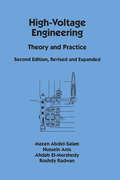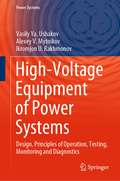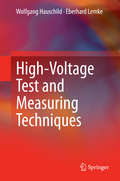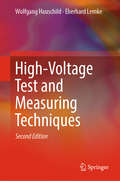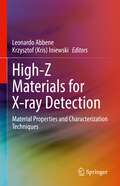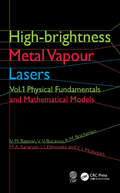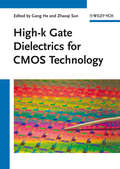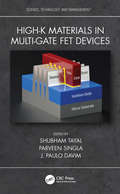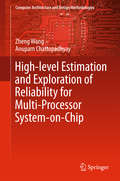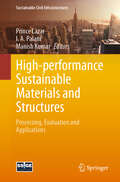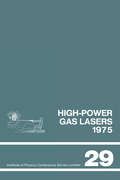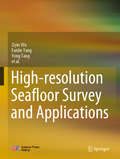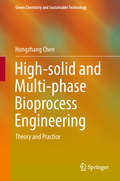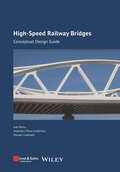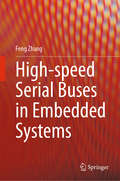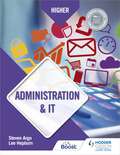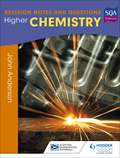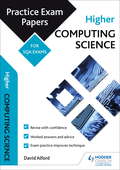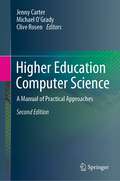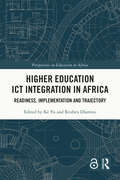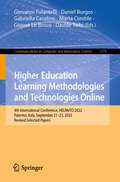- Table View
- List View
High-Temperature Superconductors (Synthesis Lectures on Materials and Optics)
by Rainer WescheThis book describes the status of research and development in the field of high-temperature superconductivity reached in the mid of the twenty-twenties. Starting from the milestones in the history of superconductivity, the main characteristics of the superconducting state are presented. Special physical properties of high-temperature superconductors are highlighted. Main classes of superconducting materials are introduced with the focus on high-temperature superconductors (cuprates and iron-based superconductors) and MgB2. Besides the material properties relevant for applications, the deposition of superconductor films and the manufacture of high-temperature superconductor wires are described. An outlook toward the future is included, covering potential applications of high-temperature superconductors in magnet technology and the electric power system.
High-Throughput Crop Phenotyping (Concepts and Strategies in Plant Sciences)
by Henry T. Nguyen Jianfeng ZhouThis book provides an overview of the innovations in crop phenotyping using emerging technologies, i.e., high-throughput crop phenotyping technology, including its concept, importance, breakthrough and applications in different crops and environments. Emerging technologies in sensing, machine vision and high-performance computing are changing the world beyond our imagination. They are also becoming the most powerful driver of the innovation in agriculture technology, including crop breeding, genetics and management. It includes the state of the art of technologies in high-throughput phenotyping, including advanced sensors, automation systems, ground-based or aerial robotic systems. It also discusses the emerging technologies of big data processing and analytics, such as advanced machine learning and deep learning technologies based on high-performance computing infrastructure. The applications cover different organ levels (root, shoot and seed) of different crops (grains, soybean, maize, potato) at different growth environments (open field and controlled environments). With the contribution of more than 20 world-leading researchers in high-throughput crop phenotyping, the authors hope this book provides readers the needed information to understand the concept, gain the insides and create the innovation of high-throughput phenotyping technology.
High-Vacuum Technology: A Practical Guide, Second Edition
by Marsbed H. HablanianOffering a basic understanding of each important topic in vacuum science and technology, this book concentrates on pumping issues, emphasizes the behavior of vacuum pumps and vacuum systems, and explains the relationships between pumps, instrumentation and high-vacuum system performance. The book delineates the technical and theoretical aspects of the subject without getting in too deep. It leads readers through the subtleties of vacuum technology without using a dissertation on mathematics to get them there. An interesting blend of easy-to-understand technician-level information combined with engineering data and formulae, the book provides a non-analytical introduction to high vacuum technology.
High-Voltage Engineering: Theory and Practice, Second Edition, Revised and Expanded (Electrical and Computer Engineering)
by Mazen Abdel-Salam"Bridges the gap between laboratory research and practical applications in industry and power utilities-clearly organized into three distinct sections that cover basic theories and concepts, execution of principles, and innovative new techniques. Includes new chapters detailing industrial uses and isues of hazard and safety, and review excercises to accompany each chpter."
High-Voltage Equipment of Power Systems: Design, Principles of Operation, Testing, Monitoring and Diagnostics (Power Systems)
by Vasily Ya. Ushakov Alexey V. Mytnikov Ikromjon U. RakhmonovThis textbook covers in detail the problem of improving the reliability and service life of high-voltage equipment in electric power systems, mainly through testing, monitoring, and diagnostics, which support the timely repair or replacement of equipment. The main focus is on high-voltage power and instrument transformers, switching devices, powerful rotating electric machines, capacitors, bushings, and power cables.The design, purpose, and principle of operation for each respective type of equipment, as well as adverse factors that can lead to defects (primarily in insulation) – and, as a result, to accelerated aging (wear) and failure – are considered.In turn, the scientific and technological foundations and practical application of testing, monitoring, and diagnostics to determine the technical condition of equipment are described. Considerable attention is paid to new and promising methods for testing under voltage (without interrupting operation) – such as pulsed flaw detection and dielectric spectroscopy. In addition, the authors propose a number of helpful physical concepts and technical solutions.The book stands out in terms of the breadth and depth of the consideration of the problem, which reflects recent trends and concepts for the development of the electric power industry, and its convincing demonstration of the capabilities of traditional and advanced methods in relation to the main equipment used in electric power systems.The textbook is intended for undergraduate and graduate students in the field of high-voltage technologies for electric power systems. It also benefits engineering personnel working with electric power systems and in the electrical industry.
High-Voltage Test and Measuring Techniques
by Wolfgang Hauschild Eberhard LemkeIt is the intent of this book to combine high-voltage (HV) engineering with HV testing technique and HV measuring technique. Based on long-term experience gained by the authors as lecturer and researcher as well as member in international organizations, such as IEC and CIGRE, the book will reflect the state of the art as well as the future trends in testing and diagnostics of HV equipment to ensure a reliable generation, transmission and distribution of electrical energy. The book is intended not only for experts but also for students in electrical engineering and high-voltage engineering.
High-Voltage Test and Measuring Techniques
by Wolfgang Hauschild Eberhard LemkeThe new edition of this book incorporates the recent remarkable changes in electric power generation, transmission and distribution. The consequences of the latest development to High Voltage (HV) test and measuring techniques result in new chapters on Partial Discharge measurements, Measurements of Dielectric Properties, and some new thoughts on the Shannon Theorem and Impuls current measurements. This standard reference of the international high-voltage community combines high voltage engineering with HV testing techniques and HV measuring methods. Based on long-term experience gained by the authors the book reflects the state of the art as well as the future trends in testing and diagnostics of HV equipment. It ensures a reliable generation, transmission and distribution of electrical energy. The book is intended not only for experts but also for students in electrical engineering and high-voltage engineering.
High-Z Materials for X-ray Detection: Material Properties and Characterization Techniques
by Krzysztof Kris Iniewski Leonardo AbbeneThis book will provide readers with a good overview of some of most recent advances in the field of High-Z materials. There will be a good mixture of general chapters in both technology and applications in opto-electronics, X-ray detection and emerging optoelectronics applications. The book will have an in-depth review of the research topics from world-leading specialists in the field.
High-brightness Metal Vapour Lasers: Volume I: Physical Fundamentals and Mathematical Models
by M. A. Kazaryan V. M. Batenin V. V. Buchanov A. M. Boichenko I. I. Klimovskii E. I. MolodykhHigh brightness metal vapor lasers have become the most bright and powerful in the visible spectral range among all existing laser types, resulting in numerous applications ranging from purely fundamental research to practical application in large-scale commercial problems such as isotope selection. This book presents a full series of fundamental problems on the development of physical fundamentals and mathematical models for practical realization of a high-power laser radiation on self-contained transitions in metal atoms. It is the first fundamental review on physics and the technique of high-brightness metal vapor lasers.
High-k Gate Dielectrics for CMOS Technology
by Gang He Zhaoqi SunA state-of-the-art overview of high-k dielectric materials for advanced field-effect transistors, from both a fundamental and a technologicalviewpoint, summarizing the latest research results and development solutions. As such, the book clearly discusses the advantages of thesematerials over conventional materials and also addresses the issues that accompany their integration into existing production technologies.Aimed at academia and industry alike, this monograph combines introductory parts for newcomers to the field as well as advanced sectionswith directly applicable solutions for experienced researchers and developers in materials science, physics and electrical engineering.
High-k Materials in Multi-Gate FET Devices (Science, Technology, and Management)
by J. Paulo Davim Shubham Tayal Parveen SinglaHigh-k Materials in Multi-Gate FET Devices focuses on high-k materials for advanced FET devices. It discusses emerging challenges in the engineering and applications and considers issues with associated technologies. It covers the various way of utilizing high-k dielectrics in multi-gate FETs for enhancing their performance at the device as well as circuit level. Provides basic knowledge about FET devices Presents the motivation behind multi-gate FETs, including current and future trends in transistor technologies Discusses fabrication and characterization of high-k materials Contains a comprehensive analysis of the impact of high-k dielectrics utilized in the gate-oxide and the gate-sidewall spacers on the GIDL of emerging multi-gate FET architectures Offers detailed application of high-k materials for advanced FET devices Considers future research directions This book is of value to researchers in materials science, electronics engineering, semiconductor device modeling, IT, and related disciplines studying nanodevices such as FinFET and Tunnel FET and device-circuit codesign issues.
High-level Estimation and Exploration of Reliability for Multi-Processor System-on-Chip
by Zheng Wang Anupam ChattopadhyayThis book introduces a novel framework for accurately modeling the errors in nanoscale technology and developing a smooth tool flow at high-level design abstractions to estimate error effects, which aids the development of high-level fault-tolerant techniques. In total, the book presents 6 solutions for reliability estimation (3 for fault injection and 3 for analytical estimation) and 5 techniques for reliability exploration (3 for architectural level and 2 for system-level). It also presents a survey of state-of-the-art problems and solutions, offering insights into reliability issues in digital design and their cross-layer countermeasures.
High-performance Sustainable Materials and Structures: Processing, Evaluation and Applications (Sustainable Civil Infrastructures)
by Manish Kumar I. A. Palani Prince LazarThis book underscores the idea of harnessing the sustainable designs and materials in nature and integrating them into the field of engineering to design innovative materials and structures with multifunctional properties targeting defense, automotive, aerospace, electronics, nuclear, healthcare, energy, sports, packaging, etc. to offer improved safety, reliability, performance, durability, sustainability, and functionality. The concept of sustainability involves the understanding of how nature has evolved solutions to various challenges over millions of years and applying these principles to design innovative materials and structures with multifunctional properties. This book provides a thorough examination of the methods and techniques used in developing sustainable materials and structures, highlighting their potential for multifunctional applications. The book delves into the expansion of our understanding in this field, which is accompanied by novel synthesis and processing methods. These methods and techniques incorporate sustainable strategies, to create innovative materials and systems to offer a wide range of properties and functions, making them highly attractive for various applications in different fields of advanced technology. In addition, these materials and structures can be tailored to have specific properties and functions, such as self-healing capabilities, high strength-to-weight ratios, and enhanced energy absorption which are the prime requirements for the researchers looking for lightweight materials and structures.
High-power gas lasers, 1975: Lectures given at a summer school organized by the International College of Applied Physics, on the physics and technology
by E R PikeThis book presents lectures and seminars given at a Summer School, organized by the International College of Applied Physics, on the physics and technology and the industrial applications of high-power gas lasers.
High-resolution Seafloor Survey and Applications
by Yong Tang Ziyin Wu Fanlin YangThis book focuses on the survey technology, post-processing technology, mapping technology and scientific application of the submarine topography and geomorphology in detail. High-resolution submarine geomorphology is a frontier branch of marine geology and marine surveying and mapping, which provides a direct basis to study the seabed surface, to understand the tectonic movement and submarine evolution. In the past two decades, high-resolution submarine geomorphology with high-precision multi-beam echo sounding, side-scan sonar and sub-bottom profiler as the major techniques, is developing very quickly and is one of the frontiers of international marine science and technology. These high techniques promote the traditional submarine geomorphology to high-resolution and quantitative research. At present, high-resolution submarine geomorphology is widely used in the delimitation of the continental shelf, the international seabed resources survey, marine engineering and marine military applications. In order to facilitate readers to understand how to acquire and apply scientific research based on submarine topographic data, it highlights the combination of theory, technology and scientific application. This book is useful as a reference for professional and technical personnel in related fields and also as a textbook for both graduate and undergraduate students as well.
High-solid and Multi-phase Bioprocess Engineering: Theory And Practice (Green Chemistry and Sustainable Technology)
by Hongzhang ChenThis book provides a comprehensive description of theories and applications of high-solid and multi-phase bioprocess engineering, which is considered as an important way to address the challenges of "high energy consumption, high pollution and high emissions" in bio-industry. It starts from specifying the solid-phase matrix properties that contribute to a series of “solid effects” on bioprocess, including mass transfer restrictions in porous media, water binding effects, rheological changes. Then it proposes the new principles of periodic intensification which combines the normal force and physiologic characteristics of microorganism for the bioprocess optimization and scale-up. Further breakthroughs in key periodic intensification techniques such as periodic peristalsis and gas pressure pulsation are described in detail which provide an industrialization platform and lay the foundation for high-solid and multi-phase bioprocess engineering. This book offers an excellent reference and guide for scientists and engineers engaged in the research on both the theoretical and practical aspects of high-solid and multi-phase bioprocess.
High-speed Railway Bridges: Conceptual Design Guide
by José Romo Alejandro Perez-Caldentey Manuel CuadradoThe need for large-scale bridges is constantly growing worldwide, as the expansion of transport infrastructures with rail roads and high-speed lines is an important current task in many regions. This book develops all aspects referring to the structural conceptional design and analysis that are taken into account when planning a bridge or viaduct for a high-speed rail line. That includes the characteristics of the railway traffic such as speeds, actions, limit states, etc., and a detailed analysis of the superstructure of the track with its various components and singular elements. One of the special features of the book is that it not only highlights the bridge typologies and structural components related to the bridge design but also takes into account the issues of the track construction. The design basis, the requirements from different situations, and solutions are given. Special attention is paid to the interactions between the structure and the track and to the dynamic nature of railway actions, studying the dynamic response of the structure and its influence on the behaviour of the track and its components as well as on safety, traffic flow quality, and maintenance needs. The particulars of the design of high-speed rail bridges located in seismic areas are included as well. Numerous examples in all chapters serve the book's character as a useful guide to HSR bridge design, and to prevent typical problems and errors. An appendix with selected HSR bridges built worldwide completes the work. With this work the authors provide first-hand experience gained from many years of planning of completed bridges for high-speed rail lines.
High-speed Serial Buses in Embedded Systems
by Feng ZhangThis book describes the most frequently used high-speed serial buses in embedded systems, especially those used by FPGAs. These buses employ SerDes, JESD204, SRIO, PCIE, Aurora and SATA protocols for chip-to-chip and board-to-board communication, and CPCIE, VPX, FC and Infiniband protocols for inter-chassis communication. For each type, the book provides the bus history and version info, while also assessing its advantages and limitations. Furthermore, it offers a detailed guide to implementing these buses in FPGA design, from the physical layer and link synchronization to the frame format and application command. Given its scope, the book offers a valuable resource for researchers, R&D engineers and graduate students in computer science or electronics who wish to learn the protocol principles, structures and applications of high-speed serial buses.
Higher Administration & IT
by Steven Argo Lee HepburnTrust our authors - whose students have achieved 100% A-C grades in Higher Admin since 2018 - to build your confidence and boost your grade.Easy to understand and enjoyable to read, this textbook takes you through all the theoretical content and practical skills, with over 60 accompanying digital tasks provided free online.> Learn and remember every topic. Simple explanations ensure that you have strong knowledge of administrative theory. Real-life case studies with differentiated exam-style questions help to check understanding before you move on.> Gain skills for the future. Digital literacy, organisational and management skills are developed throughout the course. The authors also focus on problem-solving skills, to set you up for success in the workplace.> Put skills into practice. Follow clear, step-by-step guides to using spreadsheets, databases, word processing, presentations, emails and e-diary. Apply your skills to over 60 digital tasks, which are available free online.> Prepare for assessment. 'What you should know' checklists and study activities at the end of each chapter are useful revision tools. A practice exam paper and answers are included in the book, and a practice assignment is provided online, with a full marking scheme.
Higher Administration & IT
by Steven Argo Lee HepburnTrust our authors - whose students have achieved 100% A-C grades in Higher Admin since 2018 - to build your confidence and boost your grade.Easy to understand and enjoyable to read, this textbook takes you through all the theoretical content and practical skills, with over 60 accompanying digital tasks provided free online.> Learn and remember every topic. Simple explanations ensure that you have strong knowledge of administrative theory. Real-life case studies with differentiated exam-style questions help to check understanding before you move on.> Gain skills for the future. Digital literacy, organisational and management skills are developed throughout the course. The authors also focus on problem-solving skills, to set you up for success in the workplace.> Put skills into practice. Follow clear, step-by-step guides to using spreadsheets, databases, word processing, presentations, emails and e-diary. Apply your skills to over 60 digital tasks, which are available free online.> Prepare for assessment. 'What you should know' checklists and study activities at the end of each chapter are useful revision tools. A practice exam paper and answers are included in the book, and a practice assignment is provided online, with a full marking scheme.
Higher Chemistry: Revision Notes and Questions
by David Calder John AndersonThe perfect revision companion to the Higher Chemistry textbook, this newly written resource reflects the very latest SQA curriculum.This book offers bite-sized facts, worked examples and a variety of question types to support and reinforce learning and practice for the final examination.- Dedicated sections on numeracy and researching chemistry- Provides a broad range of questions, including open-ended and past SQA exam questions- Answers section allows students to check their understanding of the standards required for Higher level success
Higher Computing Science: HCOMPPEP
by David AlfordPractise for your SQA exams with three specially-commissioned Hodder Gibson Practice Exam Papers.- Practise with model papers written and checked by experienced markers and examiners- Get extra advice with specially-written study-skills guidance sections- Gain vital extra marks and avoid common mistakes with examiner tips
Higher Education Computer Science: A Manual of Practical Approaches
by Jenny Carter Michael O’Grady Clive RosenThe march towards on-line and blended teaching—present before the Covid-19 pandemic—has been accelerated by it, and there is no going back. Students and staff may object, but the economic drive towards “greater productivity” will inevitably result in less face-to-face (f2f) instruction. Therefore, it is incumbent for those delivering this precious, in-person resource to make maximum use of time…which raises the question, “how”?The second edition of Higher Education Computer Science offers some potential answers. It also addresses other questions, such as “why have f2f teaching at all?” “what is the purpose of f2f?” and “what is the appropriate balance between the two?” The first edition began to offer suggestions for optimising limited opportunities to get together with students. Aligned with that, this unique new volume examines how to use the technology available to maximum advantage: For example, resources such as Moocs and other on-line instructional materials can provide invaluable pedagogic support. In addition, the book addresses ‘problem-based learning,’ using robotics in the teaching of programming, and a multidisciplinary approach to data science. Although it includes a chapter on distance learning, there is greater emphasis placed on the soft, transferable skills and employability skills that are best delivered in person. Further, the work provides several examples of putting theory into practice when teaching computer science at both undergraduate and postgraduate levels. Written by experienced practitioners, each chapter tackles a particular teaching activity or topic within computing, presented in such a way that other practitioners can use. As such, this new volume will be an invaluable resource to those who want to protect and optimise in-person teaching.
Higher Education ICT Integration in Africa: Readiness, Implementation and Trajectory (ISSN)
by Ke Yu Reuben DlaminiThis multidisciplinary, edited volume examines higher educations’ ICT integration in Africa, contributing a new and inclusive change readiness framework to better understand how to manage ICT or other technological disruptions in resource-restrained contexts.Tackling ICT incorporation in HEIs from different levels, chapters document case studies from countries such as Uganda, South Africa, Rwanda, Eswatini and Zimbabwe to demonstrate both the complexity of integration but also the successes it has enabled and under which conditions. The cases included in this book also exhibit better incorporation of both change content and process, while some cases also make explicit reference to other technology adoption models. Ultimately, the book highlights conceptual and empirical research to inform practices and policy development in Africa, improving multi-level success or change readiness in ICT incorporation in HEIs in Africa.Addressing various gaps in existing literature and proposing innovative solutions like the multilevel change readiness model, this book will therefore be of interest to scholars, researchers and academics in the fields of higher education, ICT integration, and educational technology more broadly.The Open Access version of this book, available at http://www.taylorfrancis.com, has been made available under a Creative Commons Attribution-Non Commercial-No Derivatives (CC-BY-NC-ND) 4.0 license.
Higher Education Learning Methodologies and Technologies Online: 4th International Conference, HELMeTO 2022, Palermo, Italy, September 21–23, 2022, Revised Selected Papers (Communications in Computer and Information Science #1779)
by Daniel Burgos Marta Cimitile Davide Taibi Gabriella Casalino Giovanni Fulantelli Giosuè Lo BoscoThis book constitutes the thoroughly refereed post-conference proceedings of the 4th International Conference on Higher Education Learning Methodologies and Technologies Online, HELMeTO 2022, held in Palermo, Italy, in September 2022. The 59 revised papers presented were carefully reviewed and selected from a total of 126 submissions. The papers present recent research on challenges of implementing emerging technology solution for online, online learning pedagogical frameworks, online learning technologies in practice, online learning strategies and resources, etc.
